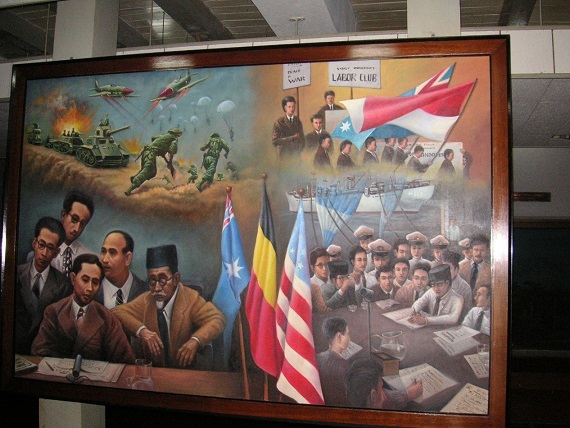Ron Witton
Paul Byleveld
In Yogyakarta’s Fort Vredeburg, one of the city’s major tourist attractions, hangs a little-known painting by the famous Indonesian painter, Amri Yahya. The painting is titled Lukisan Perjuangan dari Agresi Belanda I s/d Renville (Painting of the Struggle from the First Dutch Aggression until the Renville Agreement).
The painting is of particular interest to Australian visitors as it commemorates the support given by members of Sydney University's Labor Club to the Indonesian Republic during the early-1940s revolution. It depicts a dramatic example of Australian popular support for the fledgling republic.
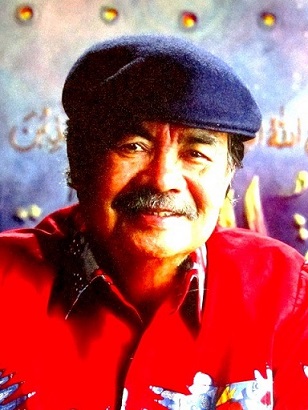 Amri Yahya Source: http://miesehati.com/wp-content/uploads/2010/12/amri-yahya.jpg
Amri Yahya Source: http://miesehati.com/wp-content/uploads/2010/12/amri-yahya.jpg
Amri Yahya was born in Palembang in 1939 and lived most of his life in Yogyakarta where he lectured at the Yogyakarta Public University (UNY). He died in December 2004 in a state of severe depression after a fire at his Yogyakarta gallery destroyed virtually all his art collection, including his first painting.
Painting of the Struggle from the First Dutch Aggression until the Renville Agreement consists of four ‘frames’, each covering crucial events in Indonesia’s struggle for independence.
The first frame (top left) depicts a scene from the conflict which later became known as the First Military Aggression. On 20 July 1947 the Dutch, claiming violations of the Linggadjati Agreement of November 1946, launched what they called a ‘police action’ to destroy the fledgling Indonesian republic.
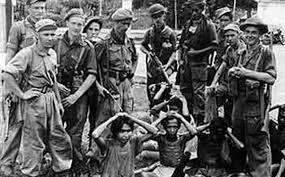 Dutch troops with captured Indonesian fighters Source: http://www.verzetsmuseum.org
Dutch troops with captured Indonesian fighters Source: http://www.verzetsmuseum.org
The second frame of the painting (top right) records that this Dutch aggression raised a storm of protest throughout the world, including demonstrations in Australia against their actions.
The most well-known demonstration in Australia occurred on 25 July 1947. Two days before, the Sydney University's Labor Club had hosted a talk by a colourful Scotswoman named Muriel Pearson who had adopted an Indonesian identity and was better known as K'tut Tantri. She was a staunch supporter of the revolutionary republican cause. K’tut Tantri had remained in Indonesia throughout the Japanese occupation (during which time she became known to the Allies as 'Surabaya Sue'), and had subsequently become a close confidant of Sukarno and other Indonesian revolutionary leaders. In 1947 she travelled to Australia as part of Indonesia’s efforts to gain international support for the independence struggle.
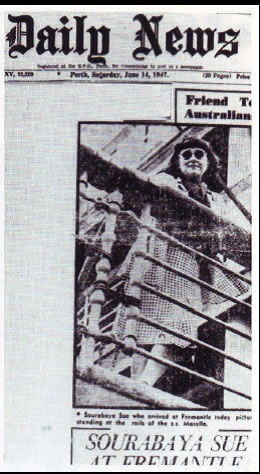 ‘Sourabaya Sue at Freemantle’, Daily News, 14 June 1947
‘Sourabaya Sue at Freemantle’, Daily News, 14 June 1947
K’tut Tantri’s fiery speech at Sydney University condemned the Dutch violation of the Linggadjati Agreement. Jan Lingard in Refugees and Rebels: Indonesian Exiles in Wartime Australia, reports that Tantri painted a graphic picture of the desperate plight of the Indonesian fighters:
'...ill equipped to fight against the planes and tanks of the Dutch. Their army is dressed in rags and has little more than bamboo spears...there are few doctors or hospitals and they are acutely short of medical supplies’.
Sydney University Labor Club students, inspired by her stirring words, immediately planned a demonstration in support of the Indonesian cause. Details of the planned demonstration were provided on the front page of the Sydney Morning Herald on 25 July 1947, along with reports of many other expressions of support for the Indonesian cause from a wide range of Australian unions and churches.
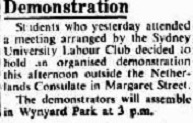 Sydney Morning Herald, 25 July 1947
Sydney Morning Herald, 25 July 1947
The Sydney Labor Club students were joined in their demonstration by other supporters of the Indonesian cause, including a large contingent of wharf labourers who had been instrumental in preventing the departure from Sydney of armament-laden Dutch ships destined to help the Dutch forces in Indonesia. The demonstration was staged outside the offices of the Dutch Consulate-General in Margaret Street in the centre of Sydney and was met with heavy-handedness from the NSW police. Such violent consequences typified the way the NSW police in those days dealt with any possibly communist-inspired demonstration. The next day’s edition of the Sydney Morning Herald (26 July 1947) had graphic photos of the melee.
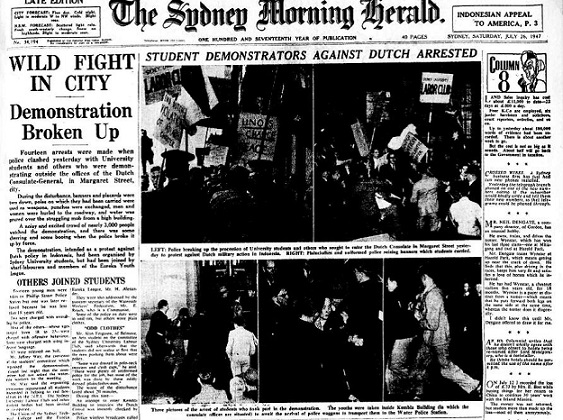 Front page, Sydney Morning Herald, 26 July 1947
Front page, Sydney Morning Herald, 26 July 1947
The demonstration was widely reported in Indonesia and was what later inspired the Amri Yahya to include the Sydney University Labor Club placard photographed on the front page of the Sydney Morning Herald in his painting. The Herald also refers to the presence at the demonstration of ‘Mrs Ketoet Tantri known as Sourabaya Sue’.
On 12 August 1947 at Lake Success, New York, the United Nations (UN) hosted discussions between Dutch and Indonesian representatives. The third frame (bottom left) depicts the actions at the UN by Indonesia’s delegation to bring the Dutch aggression to world attention. In the painting, behind Sjahrir are three significant figures of the Indonesian delegation. On the left is Soedjatmoko (known to his friends as ‘Koko’), a significant Indonesian intellectual who wrote widely on social and political issues and served as both Indonesia’s ambassador to the UN and Rector of the UN University in Japan. Behind Soedjatmoko is Soemitro Djojohadikoesoemo who later became finance minister. In the centre of the painting is Charles Tambu, a Sri Lankan lawyer who had been living in Singapore before the war and who had been captured by the Japanese and taken to Jakarta where he was placed in a ‘Radio camp’ and given the task of monitoring allied broadcasts in English. He became an effective supporter of Indonesia’s independence movement and remained a resident of Indonesia. In the 1960s he became one of Sukarno's loudest enemies, via his Jakarta-based paper, Times of Indonesia.
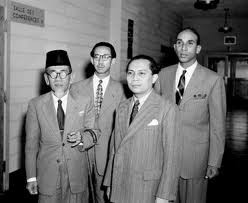 The Indonesian delegation arriving before the Lake Success UN Security Council meeting: (left to right): Agus Salim, Foreign Minister; Dr. Soemitro, Minister of Finance; former Premier Sutan Sjahrir, Ambassador-at-large; and C. Thamboe, Minister of Foreign Affairs. Source: UN Photo archive.
The Indonesian delegation arriving before the Lake Success UN Security Council meeting: (left to right): Agus Salim, Foreign Minister; Dr. Soemitro, Minister of Finance; former Premier Sutan Sjahrir, Ambassador-at-large; and C. Thamboe, Minister of Foreign Affairs. Source: UN Photo archive.
The fourth frame (bottom right) is a scene depicting the January 1948 negotiations, brokered by the UN Security Council, between the Dutch and the Indonesians. The talks were held on the USS Renville anchored in Jakarta Bay and resulted in the Renville Agreement. The agreement was an unsuccessful attempt to resolve the disputes that arose following the 1946 breakdown of the Linggadjati Agreement. The republican delegation was led by the then Prime Minister, Amir Sjarifuddin, with the prominent Christian politician, Johannes Leimena, as his deputy.
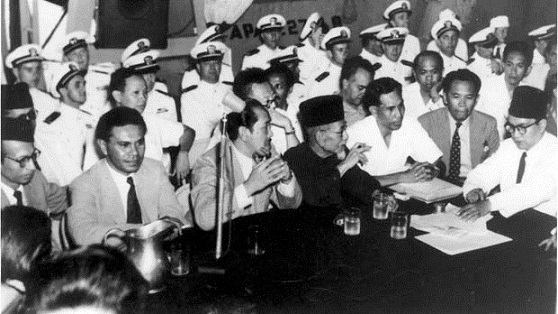 Photo taken on 17 January 1948 on the deck of USS Renville shows (right to left): Prime Minister Amir Syarifuddin, Setiadjit, Johannes Leimena, H. Agus Salim, Ali Sastroamidjojo, and Latuharhary. Source: leimena.org
Photo taken on 17 January 1948 on the deck of USS Renville shows (right to left): Prime Minister Amir Syarifuddin, Setiadjit, Johannes Leimena, H. Agus Salim, Ali Sastroamidjojo, and Latuharhary. Source: leimena.org
Events subsequent to those portrayed in the painting
The subsequent August-November 1949 Round Table Conference led to a formal transfer of sovereignty. At that Conference, the talks were held between the Indonesian Republic and the Netherlands as the two disputing parties, under the chairmanship of the United States, who the two disputing parties saw as a ‘neutral power’.
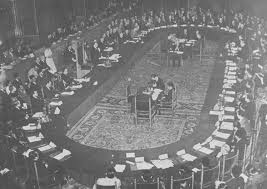 The Round Table Conference in session Source: wikipedia
The Round Table Conference in session Source: wikipedia
To represent them at the Conference, the Dutch chose Belgium, a sympathetic colonial power. Indonesia chose Australia rather than, as many expected, the newly independent country of India. This choice is perhaps explained by the popular support for the Indonesian cause in Australia as reflected in Amri Yahya’s painting. It should be noted that Australia’s delegation was headed by the judge, Sir Richard Kirby, whose exemplary efforts on behalf of Indonesia became widely known in Indonesia and resulted in his being awarded the rare honour, for a non-Indonesian, of the Bintang Jasa Utama (Supreme Service Medal).
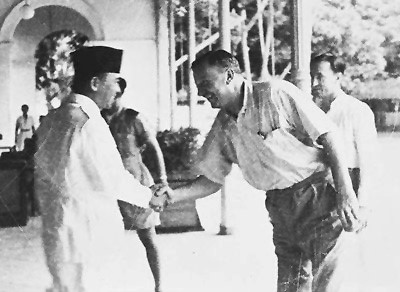 Jogjakarta, 16 November 1947, Good Offices Committee (GOC) Chairman Judge Kirby brings Dutch proposal Source: http://www.sukarnoyears.com/440australia.htm
Jogjakarta, 16 November 1947, Good Offices Committee (GOC) Chairman Judge Kirby brings Dutch proposal Source: http://www.sukarnoyears.com/440australia.htm
*****
In 1960, K’tut Tantri wrote Revolt in Paradise, a book recording her life story. Revolt in Paradise became extremely popular in Australia and throughout the world. In 1983, at the age of 85, K’tut Tantri left Indonesia and returned to Australia to continue her efforts to have a film made of her life. However, despite three decades of interest by a variety of film producers, both in Hollywood and Australia, no film was ever made, although a biography was written by Tim Lindsey who managed to get close to his subject in her last years. K’tut Tantri, in her nineties and with failing health, became a social recluse in Sydney’s fashionable Hyde Park Hotel.
Ron Witton (rwitton@uow.edu.au) has a MA in Indonesian and Malayan Studies from Sydney University and a PhD from Cornell. He has taught in Australian and Indonesian universities and still works as an Indonesian interpreter and translator. A version of this article appeared earlier as ‘Australia and Indonesia: an art history’, SAM [Sydney Alumni Magazine], Spring 2009, p.11.
Inside Indonesia 117: Jul-Sep 2014{jcomments on}
